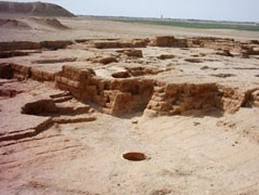Over Syrian territory lay thousands of archaeological sites where outdated cities and villages turned into piles of ruins. While excavation did only cover a small part of archaeological sites, yet it has led to the discovery of amazing civilizations as Ebla, Mari, and Ugarit which were called Mesopotamia, are by their own constituting a civilizations reservoir for the region. Their origins are deeply rooted in history going back to more than nine thousand years ago. Any person visiting north Syria cities in particular Deir el Zor, Hasakah, and Qamishli which represent the so called “Al-Jazzera” (Syrian Island), will be surprised to find a large number of archaeological missions deployed in all parts of the region.
They are exploring and looking for historical findings in one of the richest areas for ancient oriental civilizations, having witnessed many empires from Neolithic to Akkad, the first great kingdom in ancient East in the triangle of Khabour headwaters, being an independent regional civilization. Their cultural expression and material symbol is represented in pottery called Khabour Pottery Pattern. After Mitanni fall, which capital has not been found to date, Middle Assyrian kingdom leaders extended their full sovereignty on Al-Jazzera eastern side, which was the natural region for Assyria.
One of the most famous kingdoms left by Assyrians on Khabour River banks is Dor Katlimo kingdom locate now at Tel Sheikh Hamad, 68 km north east of Deir Ezzor. It was so called in cuneiform tablets found 32 years ago by an archeological expedition, is an ancient Assyrian city dating back to 4th millennium BC. Prospectors named it(Assyrian Red House) after the reddish color of paintings found the palaces walls. on It was an important staging post in Assyrian transport network and played a role in news exchange between the regions and the capital (Ashur).
The site was discovered by chance after finding a number of cuneiform panels on Khabour banks indicating the city site. Tablets discovered at the site and written in Aramaic, are rare documents as only 44 have been found in all the world. Another discovery is a small bronze statue of 17cm height in the shape of a winged man.
The empire first phase dates back to second millennium BC, whereas the second is in first millennium BC (800-500 BC), as recorded by Dor Katlimo discoverer, Dr. Hartmut kuna, professor of Archaeology and Middle East Ancient History at Berlin University.
The importance of Dor Katlimo came from its cultural role in ancient history (19th century BC), when Assyrians took control of eastern parts of northern Syria to secure trade routes going to Cappadocia and Central Asia. Therefore Dor Katlimo became an vital staging post in the transport network, giving credit to Assyrian trade and military units movements in the exchange of news between the region and the capital (Ashur).
The Middle Assyrian kingdom faced after trade collapse, a long period of deficiency caused by economic and political difficulties. As a matter of fact the Arameans (Oklamu) took control of Assyrian provinces, with the exception of Khabour and its capital Dor Katlimo which was with Shadikany kingdom. They remain an indicator of Assyrian tradition till Dor Katlimo had developed at the end of 8th century BC, after Hammurabi invasion, the most famous member of old Babylonian dynasty.
Haifaa Mafalani

